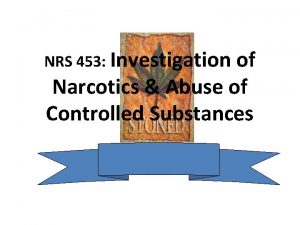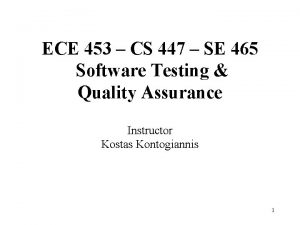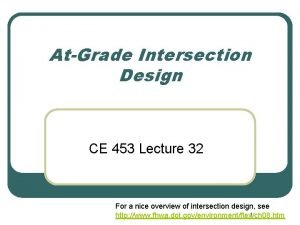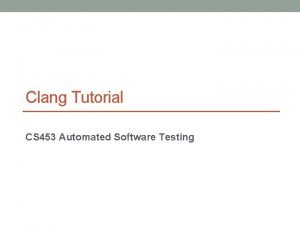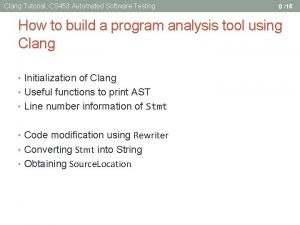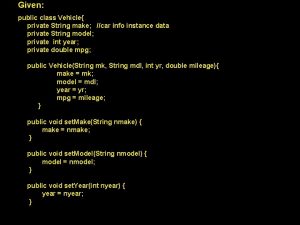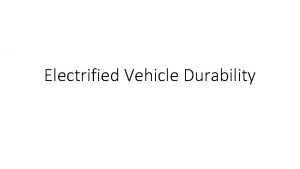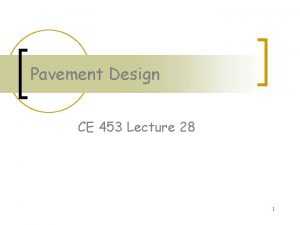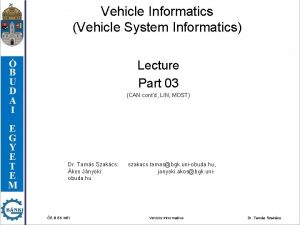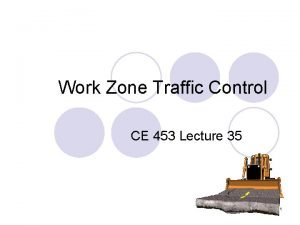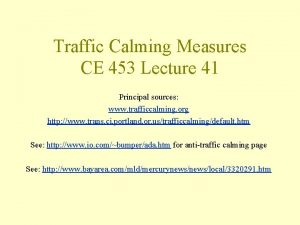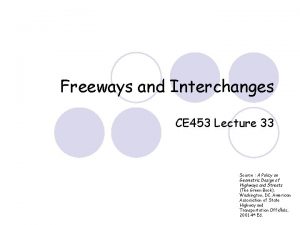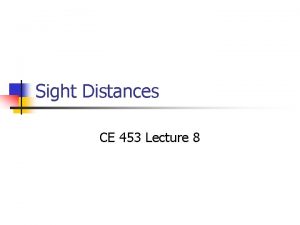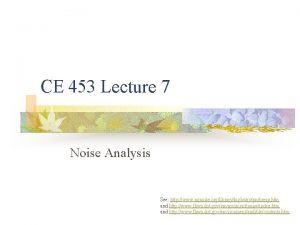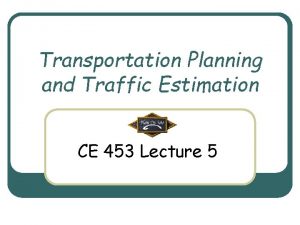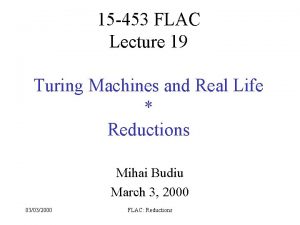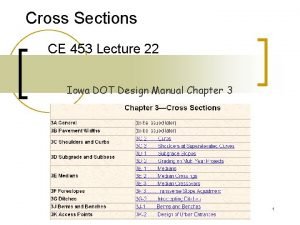CE 453 Lecture 6 Design Vehicle Design Vehicle



























- Slides: 27

CE 453 Lecture 6 Design Vehicle

Design Vehicle ► Design Vehicle – largest (slowest, loudest? ) vehicle likely to use a facility with considerable frequency ► Three characteristics that affect almost all aspects of highway design § Physical § Operating § Environmental 2

Physical Characteristics ► Type (GB defines 20 design vehicle types) § § § ► Passenger Car P Buses B Trucks SU, WB RVs Farm tractor Size § § § Length Height Width Height of driver’s eye (car: 3. 5’ – avg. , truck: 7. 6’ – high side) Center of mass 3

Dimensions of Design Vehicles 4

Operating Characteristics ► ► ► ► Acceleration Deceleration and braking Power/weight ratios Turning radius Offtracking Headlights (2’ … truck driver/retroreflectivity? ) Friction (ball bank) http: //www. cable-car-guy. com/images/ih_truck_ad_dec_1926. jpg 5

Environmental Characteristics ► ► Noise (noise meter) Exhaust Fuel Efficiency Dust (particulate and VOCs from tires and brakes) 6

Selection of Design Vehicle Key Controls ► § ► § § § Physical and Operating Key Factors Proportion and Frequency Key Types Car – parking lot SU Truck – res. Intersections, park roads City Bus – state hwy, city street, bus route ► § § See http: //www. pacebus. com/sub/guidelines/development_guidelines/ta ble%20 of%20 contents. htm for Chicago’s PACE design guide School Bus – low vol county, state hwy WB series – freeway ramp, arterial and state hwy, industrial areas, US and Interstate Highways 7

State and Local Truck Limits ► See Colorado Truck Legal Dimensions ► See http: //www. dot. state. ia. us/mvd/omve/truckguide. pdf for Iowa Truck Guide ► See http: //www. co. jasper. ia. us/new_page_7. htm for Jasper County permit requirements 8

Turn Paths ► Key variables in turn paths § Centerline turn radius § Out-to-out track § Wheelbase § Path of inner tire ► See Autoturn Software Page http: //www. transoftsolutions. com/transoft/p roducts/at/product_feat. asp 9

Minimum Turning Radii 10

11

Offtracking ► Rear wheels do not follow path of front wheels ► Increases with size of vehicle ► Decreases with radius of curve 12

13

Front Overhang and Difficulty Adjustment (Z) ► Radial distance between outside front wheel path and outside front bumper/fender ► Extra width allowance (Z) for difficulty in maneuvering 14

15

16

Total widening recommended (includes front overhang, offtracking and difficulty adj. ) Double for 4 ln undivided. Values less than 2’ may be neglected. 17

18

Widening ► Widen inside only when not using spiral (split even if using spirals) ► Paint CL and joint at middle of pavement ► Transition over superelevation transition ► Green book terminology: 19

Effect of grade on truck performance 20

Effect of grade on RV performance 21

Effect of differential speed on crash rate 22

Critical Grade ►% AND length of grade where “typical” trucks can maintain a “safe” speed See also: Highway Capacity Manual 23

Friction 24

25

26

27
 01:640:244 lecture notes - lecture 15: plat, idah, farad
01:640:244 lecture notes - lecture 15: plat, idah, farad 120 nin 50 si kaçtır
120 nin 50 si kaçtır Nrs 453
Nrs 453 Yesus kawan yang sejati
Yesus kawan yang sejati Ece 453
Ece 453 200 en yakın yüzlüğe yuvarlama
200 en yakın yüzlüğe yuvarlama Ce453
Ce453 Weerklank 453
Weerklank 453 Tim-3
Tim-3 En 453
En 453 Cs 453
Cs 453 Nrs 453
Nrs 453 Kurose
Kurose Ndc computer graphics
Ndc computer graphics Clang rewriter
Clang rewriter Ce 453
Ce 453 Cosmic superclass in java
Cosmic superclass in java Eurocode 2 lap length table
Eurocode 2 lap length table Elemen urban design
Elemen urban design Elements and principles of design ppt
Elements and principles of design ppt Lecture hall background
Lecture hall background Game design lecture
Game design lecture Computer aided drug design lecture notes
Computer aided drug design lecture notes Cmos vlsi design lecture notes
Cmos vlsi design lecture notes Which engineer may design a gps for your vehicle
Which engineer may design a gps for your vehicle Project procurement management lecture notes
Project procurement management lecture notes Lecture about sport
Lecture about sport Healthy lifestyle wrap up lecture
Healthy lifestyle wrap up lecture


